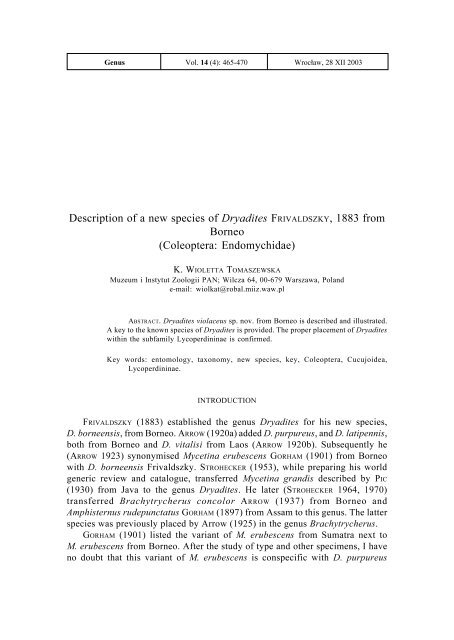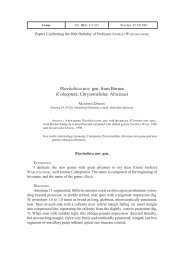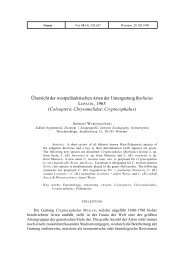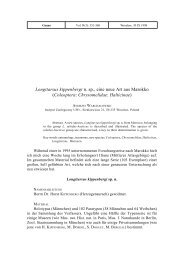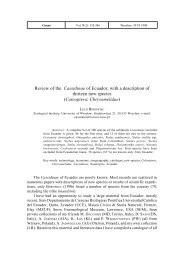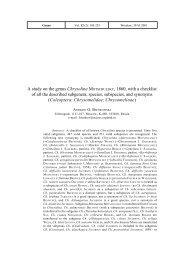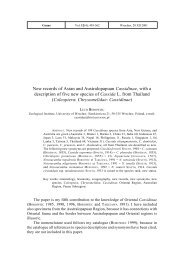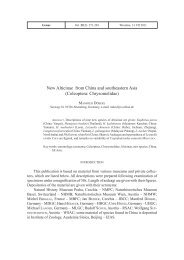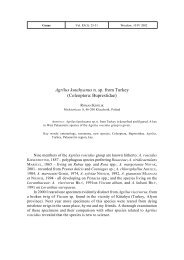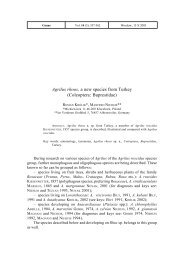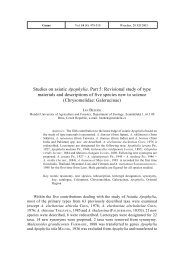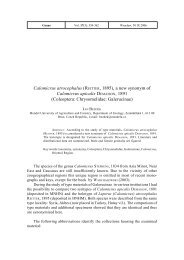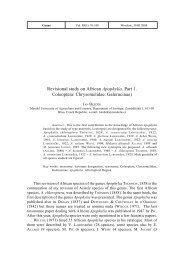Tomaszewska K. W.
Tomaszewska K. W.
Tomaszewska K. W.
Create successful ePaper yourself
Turn your PDF publications into a flip-book with our unique Google optimized e-Paper software.
Genus Vol. 14 (4): 465-470 Wroc³aw, 28 XII 2003<br />
Description of a new species of Dryadites FRIVALDSZKY, 1883 from<br />
Borneo<br />
(Coleoptera: Endomychidae)<br />
K. WIOLETTA TOMASZEWSKA<br />
Muzeum i Instytut Zoologii PAN; Wilcza 64, 00-679 Warszawa, Poland<br />
e-mail: wiolkat@robal.miiz.waw.pl<br />
ABSTRACT. Dryadites violaceus sp. nov. from Borneo is described and illustrated.<br />
A key to the known species of Dryadites is provided. The proper placement of Dryadites<br />
within the subfamily Lycoperdininae is confirmed.<br />
Key words: entomology, taxonomy, new species, key, Coleoptera, Cucujoidea,<br />
Lycoperdininae.<br />
INTRODUCTION<br />
FRIVALDSZKY (1883) established the genus Dryadites for his new species,<br />
D. borneensis, from Borneo. ARROW (1920a) added D. purpureus, and D. latipennis,<br />
both from Borneo and D. vitalisi from Laos (ARROW 1920b). Subsequently he<br />
(ARROW 1923) synonymised Mycetina erubescens GORHAM (1901) from Borneo<br />
with D. borneensis Frivaldszky. STROHECKER (1953), while preparing his world<br />
generic review and catalogue, transferred Mycetina grandis described by PIC<br />
(1930) from Java to the genus Dryadites. He later (STROHECKER 1964, 1970)<br />
transferred Brachytrycherus concolor ARROW (1937) from Borneo and<br />
Amphisternus rudepunctatus GORHAM (1897) from Assam to this genus. The latter<br />
species was previously placed by Arrow (1925) in the genus Brachytrycherus.<br />
GORHAM (1901) listed the variant of M. erubescens from Sumatra next to<br />
M. erubescens from Borneo. After the study of type and other specimens, I have<br />
no doubt that this variant of M. erubescens is conspecific with D. purpureus
466 K. WIOLETTA TOMASZEWSKA<br />
ARROW, not with D. borneensis. The variety of M. erubescens however lacks a<br />
name, and it has no nomenclatural status while ARROW’s (1920a) name purpureus<br />
is valid.<br />
Recently, while studying the Endomychidae material borrowed from the<br />
Muséum National d’Histoire Naturelle in Paris, France (MNHN) and Naturhistorisches<br />
Museum in Vienna, Austria (NHMV), a new species from Borneo has<br />
been identified and is described here as Dryadites violaceus. At present Dryadites<br />
includes eight species, all distributed in the Oriental Region.<br />
Dryadites has been traditionally classified in the subfamily Eumorphinae<br />
(STROHECKER 1953) (=Lycoperdininae) (LAWRENCE and NEWTON 1995) and in the<br />
recent classification (TOMASZEWSKA 2000), the genus was listed as a possible<br />
member of the Lycoperdininae, but awaiting further study. Examination of several<br />
species of Dryadites (D. borneensis – including the lectotype from the Hungarian<br />
Natural History Museum, Budapest (HNHM), D. purpureus – including the<br />
holotype from The Natural History Museum, London (BMNH), Mycetina<br />
erubescens var. – holotype from Museum & Institute of Zoology PAS (MIIZ),<br />
D. concolor, and D. violaceus n. sp.) confirms the subfamilial placement of the<br />
genus.<br />
TAXONOMY<br />
Dryadites violaceus n. sp.<br />
(figs 1-7)<br />
ETYMOLOGY<br />
The name violaceus refers to the violet lustre on the elytra.<br />
DIAGNOSIS<br />
Dryadites violaceus can easily be separated from all its congeners by the<br />
elytra uniformly blackish-brown or dark reddish-brown (only apices lighter) with<br />
purple-violet lustre.<br />
DESCRIPTION<br />
Length 5.30-5.50 mm. Body rather short-oval, 1.51-1.58 times as long as<br />
wide; convex; strongly shiny; colour deeply reddish-brown with dorsal surface of<br />
head, disc of pronotum, elytra and meso- and metaventrite blackish-brown,<br />
antennomeres 3-10 and at least basal half of terminal antennomere more or less<br />
infuscated.<br />
Antenna (fig. 1) 11-segmented, moderately long and rather stout, with<br />
antennomeres 1 and 3-5 more or less elongate, and antennomeres 2 and 6-8 almost<br />
as long as wide; scape about 2 times longer than pedicel and slightly longer than<br />
antennomere 3; antennomere 3 1.5 times longer than 4 or 5; antennomere 6<br />
slightly shorter than 5 and subequal in length with antennomere 8; antennomere 7
A NEW SPECIES OF DRYADITES<br />
467<br />
1-6. Dryadites violaceus n. sp.: 1 – antenna, right, dorsal, 2 – pro-, meso- and anterior margin of<br />
metaventrite, 3 – abdomen, male, ventral, 4 – abdominal ventrite 5, female, 5 – aedeagus, dorsal,<br />
6 – aedeagus, ventral
468 K. WIOLETTA TOMASZEWSKA<br />
slightly shorter than 8; club 3-segmented, moderately wide and compact. Pronotum<br />
about 1.15 mm long, 2.38-2.45 mm wide; 0.48-0.50 times as long as wide; finely<br />
and sparsely punctured; lateral margins moderately widely bordered; lateral sulci<br />
deep and comparatively long; darker area on pronotal disc placed between basal<br />
and lateral sulci extending anteriorly but not reaching anterior margin. Elytra<br />
3.75-3.80 mm long, 3.48-3.50 mm wide; 1.07-1.09 times as long as wide, 3.26-<br />
3.30 times as long as pronotum, 1.42-1.47 times as wide as pronotum; widest near<br />
basal fourth, subparallel toward apical fourth thence abruptly rounded, blunt at<br />
apices; narrowly flattened, lateral margins visible from above almost throughout;<br />
finely and sparsely punctured with additional 5 rows of moderately coarse punctures<br />
on each elytron; humeri weakly prominent. Ventral surfaces extremely finely<br />
punctured except of posterior part of metaventrite and at least intercoxal process<br />
of abdomen with coarse punctures. Mesoventrite strongly transverse with coarse<br />
ridges (fig. 2) and a pair of moderately large pits near anterior margin, laterally.<br />
7. Dryadites violaceus n. sp.: female genitalia, ventral
A NEW SPECIES OF DRYADITES<br />
469<br />
Metaventrite with very wide, highly raised anterior margin between coxae (fig.<br />
2); provided with three pairs of differently sized postcoxal pits. Abdomen (fig. 3)<br />
with ventrite 1 at least as long as three following ventrites combined; in male<br />
ventrite 5 widely rounded apically, in female somewhat triangular (fig. 4). Aedeagus<br />
rather short and stout, well sclerotized (figs 5, 6); penis curved basally with<br />
submembranous, large gonopore at apex; tegmen placed basally with short but<br />
distinct tegminal strut. Ovipositor (fig. 7) moderately sclerotized; bursa copulatrix<br />
with internal, sclerotized plates, outlet of common oviduct apically and outlet of<br />
sperm duct dorsally at about half length of bursa; coxities fused with emarginate<br />
apex, styli absent; sternite 8 sclerotized laterally and submembranous medially<br />
fused with coxities; spermatheca large, rounded, membranous; accessory gland<br />
membranous, strongly elongate with additional, apical long and narrow process.<br />
TYPE MATERIAL<br />
Holotype female: “Sarawak (Borneo), ca 25 km E. Kapit, III.1994, Kodada<br />
leg.” (NHMV). Paratype male: “Borneo Occ, Pontianak 1901/ Muséum Paris,<br />
Coll. Oberthür.” (MNHN).<br />
NOTE. The male specimen seems not to be fully pigmented (teneral), therefore<br />
the female was chosen as the holotype.<br />
DISTRIBUTION<br />
Indonesia (Borneo).<br />
KEY TO THE SPECIES OF DRYADITES<br />
1. Whole body deeply black ……….……….......................….....……………. 2.<br />
–. Body not as deeply black and at least pronotum and/ or elytra with red areas<br />
……............................................................................................................ 3.<br />
2. Eytra dull black, short-cordiform, covered with rows of very large, deep<br />
punctures; Assam, Burma ……………........….. D. rudepunctatus (GORHAM)<br />
–. Elytra shiny, long-oval, with extremely minute punctures (looks like<br />
impunctate); Borneo …………………………………… D. concolor (ARROW)<br />
3. Elytra uniformly blackish-brown or dark reddish-brown (only apices may be<br />
lighter) with purple-violet lustre; [aedeagus as in figs 5, 6); Borneo ..……....<br />
.................................................................................…… D. violaceus n. sp.<br />
–. Elytra blackish, decorated with red maculae ……..........................……..… 4.<br />
4. Elytra without distinct, regular rows of punctures; [red macula on each elytron<br />
very large]; Java …………………………................……………grandis (PIC)<br />
–. Elytra with distinct, regular rows of punctures ….....................…………... 5.<br />
5. Red macula covering most of elytron ……………...........................………. 6.<br />
–. Red macula covering at most half of elytral length ……….................…… 7.<br />
6. Body smaller (about 5 mm long); shape of elytral macula follow outline of<br />
elytron, distant from base; suture moderately widely black; Borneo …............<br />
....................................................................................... D. latipennis ARROW
470 K. WIOLETTA TOMASZEWSKA<br />
–. Body larger (about 7 mm long); elytral macula almost touching base of<br />
elytron; suture very narrowly black; Laos, Vietnam ……….................<br />
..................................................................................…… D. vitalisi ARROW<br />
7. Elytra deep purple with maculae almost rounded, extending along posterior<br />
half of each elytron; Borneo ………………………..….. D. purpureus ARROW<br />
–. Elytra black with maculae of irregular anterior and posterior edges, extending<br />
along central part of each elytron, leaving basal- and apical fourth of elytra<br />
black; Borneo ………………………........………… D. borneensis FRIVALDSZKY<br />
ACKNOWLEDGMENTS<br />
Nicole BERTI (MNHN), Max BARCLAY (BMNH), Otto MERKL (HNHM) and<br />
Rudi SCHUH (NHMV) are very sincerely acknowledged for the loan of the specimens<br />
used in this study. Additional material examined during preparation of this<br />
paper belongs to the Museum and Institute of Zoology PAS, Warsaw. I would like<br />
to thank Richard LESCHEN for reading, commenting and correcting an earlier<br />
version of this paper.<br />
REFERENCES<br />
ARROW, G.J., 1920a. A contribution to the classification of the coleopterous family Endomychidae.<br />
Trans. Entomol. Soc. London, 1–83 pp., pl. 1.<br />
–, 1920b. A list of the endomychid Coleoptera of Indo-China, with descriptions of new species. The<br />
Ann. Mag. Nat. Hist., ser. 9, 5: 321–336.<br />
–, 1923. Notes on Endomychid Coleoptera and descriptions of new species in the British Museum.<br />
Trans. Entomol. Soc. London, 484–500 pp.<br />
–, 1925. Coleoptera. Clavicornia. Erotylidae, Languriidae and Endomychidae. In: The Fauna of<br />
British India, including Ceylon and Burma. Taylor and Francis, London, xv + 416 pp., pl. 1,<br />
map 1.<br />
–, 1937. Notes on some clavicorn Colepoptera and descriptions of a few new species and genera.<br />
Ann. Mag. Nat. Hist., ser. 10, 20: 101–113.<br />
FRIVALDSZKY, J., 1883. Endomychidae in Asia Orientali a J. XANTUS collectae. Termesz. Fuz., 123-<br />
133.<br />
GORHAM, H.S., 1897. Description of new species of Coleoptera of the family Endomychidae from the<br />
Eastern Hemisphere. Proc. Scient. Meet. Zool. Soc. London, 456-464 pp., pl. 32.<br />
–, 1901. Erotylidae, Endomychidae and Coccinellidae of Sumatra. Stett. Ent. Zeitung, 62: 169-214.<br />
LAWRENCE, J.F., NEWTON, A.F., 1995. Families and subfamilies of Coleoptera (with selected genera,<br />
notes, references and data on family-group names), pp. 779-1006. In: J. PAKALUK and S.A.<br />
ŒLIPIÑSKI (eds.), Biology, phylogeny and classification of Coleoptera. Papers celebrating the<br />
80 th Birthday of Roy A. Crowson. Volume 2, Muzeum i Instytut Zoologii PAN, Warszawa.<br />
PIC, M., 1930. Nouveautés diverses. Mélang. Exot.-Entomol., 56: 1-36.<br />
STROHECKER, H.F., 1953. Coleoptera Fam. Endomychidae. In: WYTSMAN P. (ed.), Genera Insectorum.<br />
Desmet-Verneuil, Bruxelles, 140 pp., 5 pls.<br />
–, 1964. A synopsis of the Amphisternini (Coleoptera: Endomychidae). Pacific Insects, 6: 319-357.<br />
–, 1970. The genera Beccariola, Dryadites and Cymbachus (Coleoptera: Endomychidae). Pacific<br />
Insects, 12: 49–66.<br />
TOMASZEWSKA, K.W., 2000. Morphology, phylogeny and classification of adult Endomychidae<br />
(Coleoptera: Cucujoidea). Ann. Zool., Warszawa, 50: 449–558.


